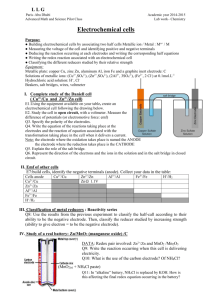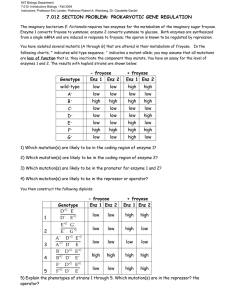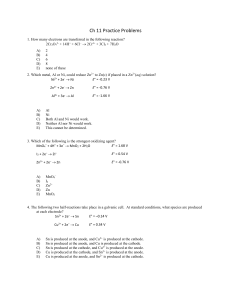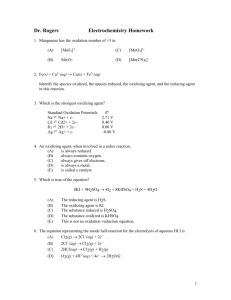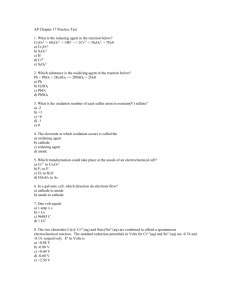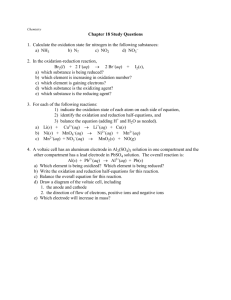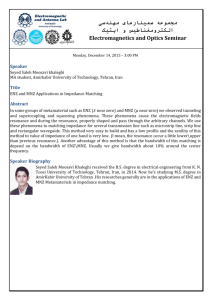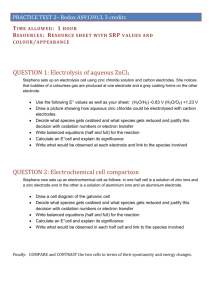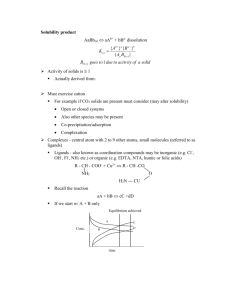1) In the reaction H2O + CH3COOH H3O+ + CH3COO
advertisement
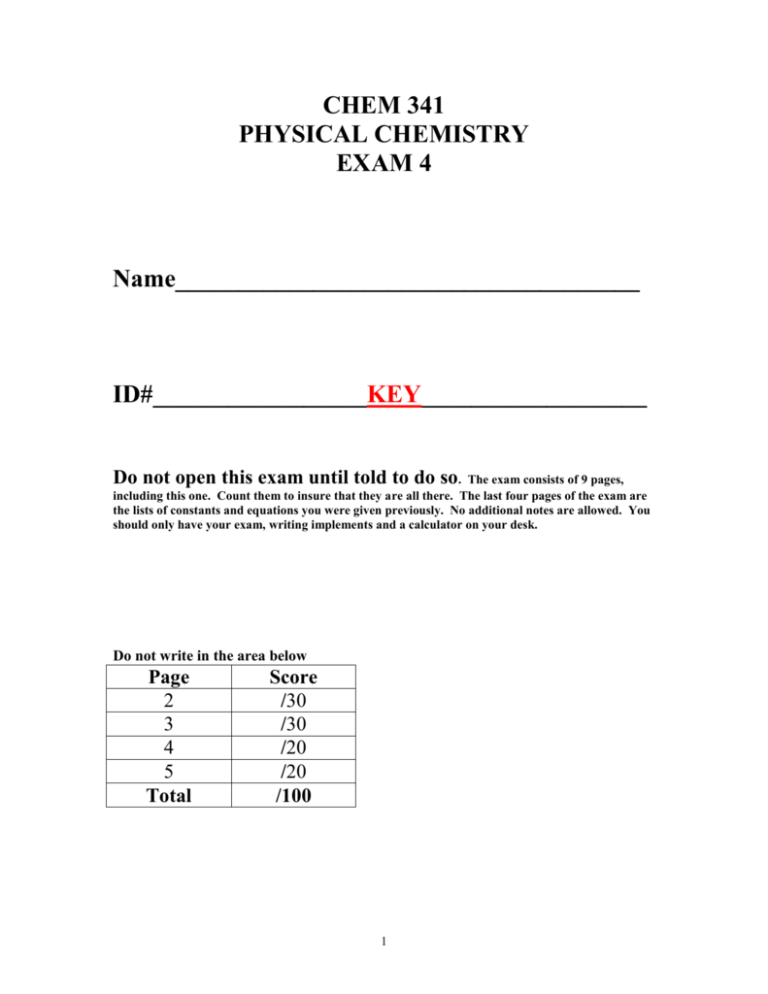
CHEM 341 PHYSICAL CHEMISTRY EXAM 4 Name_____________________________________ ID#_________________KEY__________________ Do not open this exam until told to do so. The exam consists of 9 pages, including this one. Count them to insure that they are all there. The last four pages of the exam are the lists of constants and equations you were given previously. No additional notes are allowed. You should only have your exam, writing implements and a calculator on your desk. Do not write in the area below Page 2 3 4 5 Total Score /30 /30 /20 /20 /100 1 Conceptual Problems. For these five problems, you do not need to justify or explain your answer. Each problem is worth 5 points 1) What is the OH concentration (in units of moles per liter) of an aqueous solution of pH 6? OH HKO 10 W 8 M 3 2) The oxidation/reduction reaction Cu2+(aq)+ SO42-+ Zn(s) Cu(s) + Zn2+(aq) + SO42-(aq) is spontaneous. Is the standard potential for this reaction greater than zero, less than zero, equal to zero or impossible to determine? Greater than zero. 3) In a galvanic cell such as a chemical battery, does an oxidation reaction occur at the positive electrode, the negative electrode, both electrodes or neither electrode? The negative electrode: the oxidation reaction gives up electrons to the electrode making it negative. 4) What are the units of the rate constant for the irreversible reaction A B+C? s-1 : It is first order in this direction 5) In the irreversible reaction A + B C, if one increases the concentration of C, will the rate of change in the concentration of A increase, decrease, remain the same or is it impossible to tell? Remain the same: the reaction is irreversible and therefore the amount of product has no effect on the rate. 2 Numerical Problems. You must show all your work for complete credit. 6) (20 points) Consider an aqueous solution which contains 0.010 M acetic acid (CH3COOH), 0.010 M sodium acetate (Na+ CH3COO-) and 0.010 M sodium chloride (Na+ Cl-). The pKA of acetic acid is 4.75. a) Assuming that all activity coefficients are one, what is the pH of the solution ? Justify your answer with an equation. b) Determine the ionic strength of the solution. c) Determine the average activity coefficient for sodium acetate in the solution. d) Using the activity coefficient that you calculated, estimate the pH that you would actually measure of this solution using a pH meter. a) pH pK A log CH COO pK 3 CH 3COOH A 4.75 b) 2 2 2 I 0.5 mi z i2 0.5 m Na 1 m Acetate 1 mCl 1 0.50.020 0.010 0.010 0.020 i c) log 10.509 0.020 0.0720 0.847 d) pH pK A log CH 3COO CH 3COOH 4.68 3 7) (20 points) Let's say that a galvanic cell (spontaneous oxidation/reduction reaction like a battery) is constructed using the half reactions Cu2+(aq) + 2e- Cu(s) (E0 = +0.34V) and Zn2+ + 2e- Zn(s) (E0 = -0.76V). What ratio of concentrations, Zn2+/Cu2+, in the electrolyte will be required if one wants a 1.10 V zero current potential? Assume that the temperature is 298 K and that all activity coefficients are one. Hint: What is Q in the Nernst Equation for this reaction? The reaction is spontaneous, so the voltage must be positive. Therefore the reaction is: Cu2+(aq) + Zn(s) Cu(s) + Zn2+(aq) E0 = 1.10 For this reaction: Q aCu ( s ) a Zn 2 aCu 2 a Zn ( s ) a Zn 2 aCu 2 Zn 2 If all of the activity coefficients are assumed to be 1.00 then: Q Cu 2 RT Zn 2 Thus the Nernst equation becomes: E E 0 ln F Cu 2 Zn e Therefore: Cu 2 2 F RT E E 0 1.00 4 8) (20 points) For the elementary reaction series A+B C D, for components C and D only, give a) the rate equations (differential equations describing the rate of change in concentration of each component with time), b) the values of the initial rates of change of C and D and c) the final concentrations of C and D when the reaction comes to equilibrium. Note that the initial concentrations are A0 = B0= 0.30 M, C0 = 0.20 M, D0 = 0.00 M. The rate constant for the first reaction, k1, is 30 M-1 s-1, the forward rate constant for the second reaction, kf2, is 15 s-1 and the reverse rate constant, kb2, is 10 s-1. dC k1 AB k f 2 C k b 2 D dt a) dD k f 2 C k b 2 D dt initially : dC 0 M b) 30M 1 s 1 0.30M 0.30M 15s 1 0.20M 10s 1 0.00M 0.30 dt s dD0 M 15s 1 0.20M 10s 1 0.00M 3.00 dt s D k f 2 1.5 C k b 2 D C 0.3M 0.2M 0.0M c) 1.5C C 0.5 C 0.2M D 0.3M K eq 0.5M 5 Applied Problem. You must show all your work for complete credit. 9) (15 points) The purpose of a catalyst is to lower the activation energy of a reaction (in fact, that is all that a catalyst does). The enzymes in your body which mediate chemical reactions are catalysts. One of these enzymes is called catalase and it catalyzes the breakdown of hydrogen peroxide: 2H2O2 (hydrogen peroxide) 2H2O + O2. At 20 C, the uncatalyzed rate of this reaction is quite slow, taking days to weeks for an open bottle of hydrogen peroxide to decay. When the enzyme is added, the rate increases by a factor of 108 at the same temperature (in other words, k enz 108 ). Assuming that the rate is related to the activation energy in the usual k noenz way (k is proportional to e E A / RT ), determine how much the enzyme lowers the activation energy for this reaction. The ratio of the rates with and without enzyme is 108. Therefore: k e E A enz / RT 10 8 enz E A noenz / RT e E A noenz E A enz / RT k noenz e ln 10 8 E A noenz E A enz / RT E A noenz E A enz RT ln 10 8 44.9 kJ mole 6
